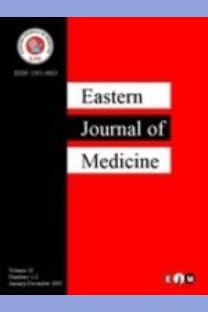Is accompanying organ damage related with mortality in renal trauma?
___
Gedik A, Gedik E, Deliktaş H, Şahin H, Bircan K. Blunt and penetrating renal injuries: 18-year experience. Turkish Journal of Urology 2009; 35: 43-48.Shoobridge JJ, Corcoran NM, Martin KA, Koukounaras J, Royce PL, Bultitude MF. Contemporary Management of Renal Trauma. Rev Urol 2011; 13: 65-72.
Ekşi M, Atar FA, Evren I, Şeker KG, Şam E, Tugcu V. Our clinical approach to renal trauma: Eight years experience. The New Journal of Urology 2016; 11: 28-31.
Shoobridge JJ, Bultitude MF, Koukounaras J, Martin KE, Royce PL, Corcoran NM. A 9-year experience of renal injury at an Australian level 1 trauma centre. BJU Int 2013; 112: 2: 53-60.
Heyns CF. Renal trauma: indications for imaging and surgical exploration. BJU Int 2004; 93: 1165- 1170.
Santucci RA, McAninch JM. Grade IV renal injuries: evaluation treatment, and outcome. World J Surg 2001; 25: 1565-1572.
Lanchon C, Fiard G, Arnoux V, et al. .High Grade Blunt Renal Trauma: Predictors of Surgery and Long-Term Outcomes of Conservative Management. A Prospective Single Center Study. J Urol 2016; 195: 106-111.
Matthews LA, Spirnak JP. The nonoperative approach to major blunt renal trauma. Semin Urol 1995; 13: 77-82.
Goff CD, Collin GR. Management of renal trauma at a rural, level I trauma center. The American Surgeon 1998; 64: 226-230.
Moudouni SM, Hadj Slimen M, Manunta A, et al. Management of majör blunt renal lacerations: is a nonoperative approach indicated? Eur Urol 2001; 40: 409-414.
Tuğcu V, Şahin S, Özbay B, et al. Our clinical approach in patients with renal injury Med J Bakirköy 2006; 2: 97-100.
Boone TB, Gilling PJ, Husmann DA. Ureteropelvic junction disruption following blunt abdominal trauma. J Urol 1993; 150: 33-36.
Sahin H, Akay AF, Yılmaz G, Tacyildiz IH, Bircan MK. Retrospective analysis of 135 renal trauma cases. Int J Urol 2004; 11: 332-336.
Wessells H, Suh D, Porter JR, et al. renal injury and operative management in the United States: results of a population- based study. J Trauma 2003; 54: 423-430.
Danuser H, Wille S, Zoscher G, Studer U. How to treat blunt kidney ruptures: primary open surgery or conservative treatment with deferred surgery when necessary? Eur Urol 2001; 39: 9-14.
Herschorn S, Radomski SB, Shoskes DA, Mahoney J, Hirshberg E, Klotz L. Evaluation and treatment of blunt renal trauma. J Urol 1991; 146: 274-276.
Moore EE, Shackford SR, Pachter HL, et al. Organ injury scaling: spleen, liver, and kidney. J Trauma 1989; 29: 1664-1666.
McAninch JW, Carroll PR, Armenakas NA, Lee P. Renal gunshot wounds: methods of salvage and reconstruction. J Trauma 1993; 35: 279-283.
Mc Aninch JW. Gillenwater JY, Grayhack JT, Howards SS, Duckett JW, editors. Renal injuries. In: Adult and pediatric urology. 3rd ed. St. Louis: Mosby 1996; 539-553.
Bjurlin M, Goble S, Fantus R, Hollowel C. Outcomes in geriatric genitourinary trauma. J AM Coll Surg 2011; 213: 415-421.
Bent C1, Iyngkaran T, Power N, et al. Urological injuries following trauma. Clin Radiol 2008; 63: 1361-1371.
Nguyen HT, Carroll PR. Blunt renal trauma: renal preservation through careful staging and selective surgery. Semin Urol 1995; 13: 83-89.
- ISSN: 1301-0883
- Başlangıç: 1996
- Yayıncı: ERBİL KARAMAN
Anthrax in pregnancy: Case Report
Siti Nor Fadhlina MİSRON, Zahiruddin OTHMAN, Lukmanul Hakim MİSRON
HAMİT HAKAN ALP, FATMA ZÜHAL UMUDUM, EBUBEKİR BAKAN
Is accompanying organ damage related with mortality in renal trauma?
Recep ERYILMAZ, Murat DEMİR, RAHMİ ASLAN, KEREM TAKEN
Herpes encephalitis with atypical localization presented through status epilepticus
Retrospective analysis of patients who underwent spinal fusion surgery
Can kinesio taping be a novel treatment option for Emesis Gravidarum? A randomized preliminary study
ERBİL KARAMAN, ŞEYHMUS KAPLAN, Mahmut ALPAYCI, ORKUN ÇETİN, ALİ KOLUSARI, Hanım Güler ŞAHİN
A case of massive atenolol overdose successfully managed with intravenous calcium chloride
Ley Khim TEO, Daniel Je Wai THAM, Chee Ping CHONG
Ahmed A. KHALİFA, Sheref A. ELSEİDY, Ahmed M. KHALİFA
Mortality and severity related factors during the admission: H1N1 pneumonia
HANİFİ YILDIZ, SELAMİ EKİN, Ahmet ARISOY, HÜSEYİN AKDENİZ, SELVİ AŞKER, AYSEL SÜNNETÇİOĞLU, HÜLYA GÜNBATAR, Mehmet Hakan BİLGİN, MESUT ÖZGÖKÇE, MAHFUZ TURAN, Hasan Ali GÜMRÜKÇÜOĞLU, Nureddin YÜZKAT
